Television Equipment Collection
I have a personal collection of television production equipment, which follows on from the Museum collection. At present it is not located in a display situation, but through the wonders of the World Wide Web we can display the items here.
These items form a personal collection, and are not for sale, although some items are available for hire. |
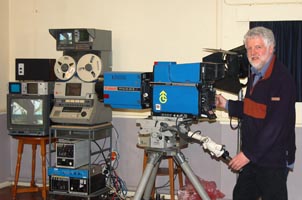 |
Some items are also part of our ongoing projects, which are described HERE.
More information will be added from time to time, but we do have a lot of equipment which has not been photographed. Some items are for sale- have a look HERE if you are interested in Cameras, VTRs and other equipment either for use or as collector's items. |
|
Cameras
Bosch Fernseh KCU40
Early (1969) Colour camera,3 tube (plumbicon) studio or OB. Various lenses were available.
This camera was from a Yorkshire Televsion OB unit, and was one of several originally donated to the Broadcasting Museum by Manchester Metropolitan University just before the demolition of the studios at Didsbury. I did have several lenses and heads, plus a quantity of CCUs, control panels and spares, but some went with the Museum collection and ended up at the NMM in Bradford, some went to other collectors. I kept one head and what I thought was a lens in a flight case, only to discover some time later that there was no lens inside! I would like to find a lens, preferably an Angenieux. There is a CCU and PSU somewhere, but trying to get it working is not on the agenda for now.
|
No pic yet |
EMI 201
Monochrome Vidicon studio camera. 4 lens turret. 405/625 line.
These were one of the least expensive studio cameras for broadcasting, and were introduced towards the end of the monochrome era. Because they used a Vidicon tube, they would never cope well with moving subjects, due to the inherent lag. A fast moving subject would tend to smear, but these cameras were used in news studios or even just for static captions- it saved tying up an expensive I.O. camera. Also, if the contrast ratio was well controlled, lag was minimised, so they were also used for telecine applications.
My example, the head at any rate, came from an ex- Scottish Television EMI telecine, where it was used with a field lens with a 3-port splitter, taking a 35MM Kalee projector, 35MM slide projector, and a 16mm projector with sound follower. It was bought from STV by Manchester Polytechnic (Now MMU) and was used to run film inserts, sometimes on negative film, as you can invert the video. I remember racking it on a student production using 16MM neg., which was not easy as the controls worked backwards! It was eventually scrapped, and sad to say the CCU and monitor were skipped, but the head was kept and I was given it as a leaving present. I did get another one with a CCU for the Museum, which was ex-BBC, bought at auction, but decided to keep this head because of its history. Presumably the other channel is still in the BBC-NMM collection.
The CCU I have now is believed to come originally from Southern Television, along with 2 lenses. 2 more would be nice! One day it would be good to get it going, but again not a priority.
|
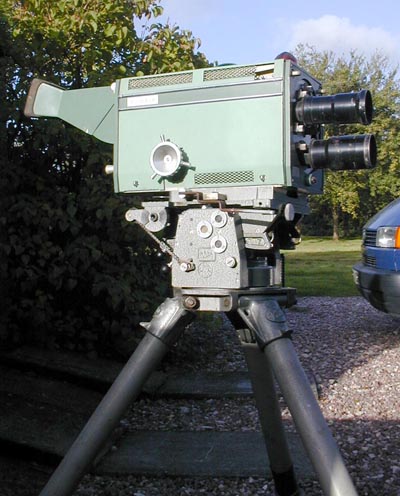 |
EMI 2001
4-Tube colour camera, originally produced in 1966 using 30mm Plumbicon tubes and Nuvistor head amps, then later modified to use seperate mesh tubes and FET head amps. The early Plumbicon versions are designated Type 2001, the later ones 2001/1. (They are not interchangeable, as the power supplies are different.)
These were one of the most popular colour cameras for studio and OB use in the UK, despite the fact that the design precluded the use of more than a couple of different lens packages. The head is built around a central chamber that holds the lens, which does not project outside the body (except with the longer focal length lens). This construction made the camera exceptionally natural to handle, endearing it to operators. The BBC equipped most of the studios in Television Centre with them.
The 2001 was simpler in design but was robust, (relatively) reliable and gave good pictures if set up properly. Because all four tubes have to be registered accurately to give a sharp picture, it is easy for the alignment to go out and the pictures become blurred. Despite this, there are many programmes still going out on TV networks all over the world ('Fawlty Towers', 'Dad's Army' and many others) which were shot on 2001s. Take a look at 1970s 'Top Of The Pops' to see what could be done with a few star filters, (and an ingenious 45 degree tilt mounting). Several engineers I have spoken to, who together had thousands of hours experience with all sorts of cameras, considered that the best pictures in the early days of colour from the BBC were from the Pye/Philips PC80s, which were not widely purchased, maybe due to their non-British origin. Next best were the 2001s, which were liked but as they were kept in use for so long, naturally gradually got less reliable. Their four-tube configuration inevitably resulted in a softer image.
The BBC kept 2001s in use until the late 1980s on 'Eastenders', where they still produced some cracking pictures even under the lower lighting levels then in use. In the early days of colour, the accepted view was that high lighting levels were needed to get good colour pictures, mainly to reduce the signal to noise ratio. However, with the more naturalistic lighting used in later drama productions the 2001s showed themselves capable of giving subtle pictures that stand up well today against the rather brash colourimetry of CCDs- although they could be noisy in the blacks.
I just missed out on lighting for 2001s, the last one in use in HTV went just a couple of months before I started. I believe the last ones in broadcast use in the BBC may have been at BBC Bangor. They became the standard colour camera within the BBC and many ITV companies during the early 70s,- Granada, ITN, Thames, HTV, Yorkshire and others all adopted them. They used the monstrous G101 colour cable, which was standard at this time as it was used by EMI, Marconi and Philips/Pye. The standard BBC OB drum holds 100ft, which is a struggle for two men to lift, and on many OBs a run of 1000-2000ft was standard. Think of the rigging!
I have a total of 6 complete 2001 channels, and 2 heads, 2 are for use with North 3. Only 2 are ex- BBC (believed originally from Glasgow),one from Granada, one form Yorkshire TV. One may be originally from Thames, the other two I originally acquired from the remains of a failed Beatles museum in Liverpool, where they had been used as props. They have large glue patches covering the side panels, indicating a full-length logo had been stuck there. I can't find pictures of such cameras- anybody know more? ATV? YTV? Tyne-Tees? A manual I got with them was marked 'Studio D'. They don't have the BBC viewfinder bracket mod. Your suggestions welcome.
So, the 2001 was an excellent camera in its day, but now they have problems with the usual problems with faulty transistors and corroding components. The viewfinders were also a bit iffy. The two cameras for North 3 have now been almost fully restored, entailing a lot of work over a period of several years due mainly to transistor failures but they have gradually become more and more reliable as faults have been fixed.
Another problem for the installation of the 2001s in North 3 is that the Operator's Control Panels (OCPs) installed in the Vision Control desks were for the Pye PC80s, and although i have now located and fitted the OCPs, there are still no Colour Balance panels. I am therefore very keen to buy (or swap things for) these panels. I would be also be interested in any 2001 related parts and Vol. 2 (or a full set) of the manuals. And the same for the Pye PC80s of course.!
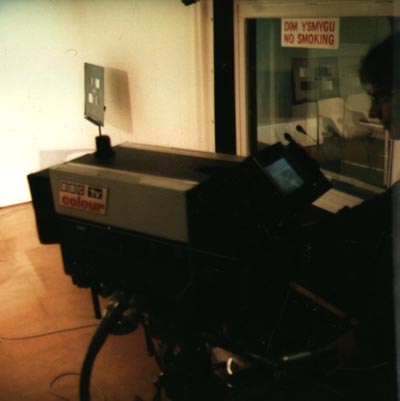
One of the last 2001s in use in the BBC, c.1990 at BBC Bangor. (Photo- Peter Macmillen)
|
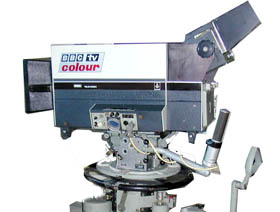
One of the ex-BBC 2001s for North 3.
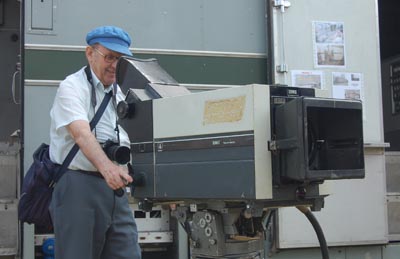
Another, out on display with N3, with one of the men who operated them for real. Sadly, no longer with us.
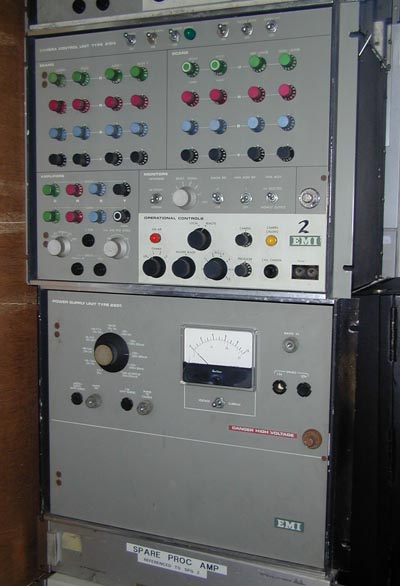
2001 Camera Control Unit and Power Supply.

Off-screen photo (from Prowest monitor in N3) showing EMI 2001 picture (2018) |
Hitachi FP Series
One of the major Japanese companies who went into TV camera production during the 1980s. This range of hand-held 3 tube cameras was produced for industrial, teaching and budget broadcast applications. I have several FR21/FP23 bodies but only one complete with lens and viewfinder, which was working OK when last tried. I would be willing to sell or swap a couple of these, which are believed working.
The FP-Z31 is a higher spec. broadcast quality ENG/EFP portable. I have a nice example in a flightcase with mains PSU and accessories. Fitted with a Fujinon lens. It works OK, although the green tube is trailing a bit on highlights. No known history.
|
No pic yet |
Hitachi 'Computacam' SK91
One of the first broadcast quality hand-held cameras, utilising digital memory for the set-up adjustments. Slightly smaller than its Sony or Ikegami rivals. This camera is fitted with a Triax back, a revolutionary system of camera control which dispensed with the conventional multi-core cable, using a three-core co-axial cable capable of carrying mains, video, audio and control signals from a CCU base station to the head. Very long lengths of lightweight cable could be used giving increased flexibility- the system is still used. The SK-91 could be used as a stand-alone or with the Triax unit as a studio camera.
I have a complete example with monocular and studio viewfinders, Fujinon lens and CCU. It did work after a fashion but the Triax unit is faulty. There is another head for spares. It has broadcast provenance, but history not known.
|
No pic yet |
Ikegami HL79
One of the first and arguably the best hand-held/studio cameras to come out in the late 70s. (The HL77 was the first in the series.) This camera revolutionised TV production techniques, enabling directors to get shots they could not hope to achieve with conventional studio cameras. Close-ups of keyboard player's hands, bass drum pedals, and hand-held tracks along audiences abounded, in what traditional studio cameramen, used to gliding their half-ton monsters around the studio, derisively called 'Wobblyscope'.
The HL79 series extended to several models, the most popular probably being the HL79D. (Yes, HL really did stand for 'Handy Looky'!) Rather an uncompromising looking grey box, it was superbly rugged and well suited to either studio, OB, ENG or EFP use. The connections were of military quality, and these cameras withstood being dropped (even into water), dragged around and generally abused. I have several examples, in varying condition, probably the best being ex-BBC. These seem to have seen service at Television Centre, (one has a 'Going Live!' sticker on) then Wood Norton (the BBC training college) So they have had a hard life, but even then after several years of storage they powered up and immediately gave clean sharp pictures.
I remember the HL79 in service, HTV had them on the OB units, and they were very reliable. They could be configured for stand-alone use with a recorder such as a BVH500, BVW15 or BVU-series, using a special adapter, or they could be fitted with a multicore (TV36) back. Later versions had Triax capability. I have 2 of these, and 2 CCU 'base stations', which all worked when I got them but I think are now faulty. There is also an experimental Triax system made by the BBC, a studio viewfinder conversion and a special large monocular viewfinder used for drama EFP. There are both standard (with 2x extender) and wide angle lenses, and a couple of spare heads.
I would like the later 'E' version, I have several lenses which will fit these and later cameras but the connectors are wrong for the 'D' model. Ikegami use a reversed type of lens mount compared to the B4 mount used by Sony.
|
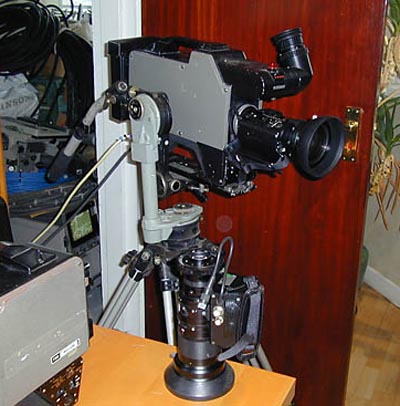
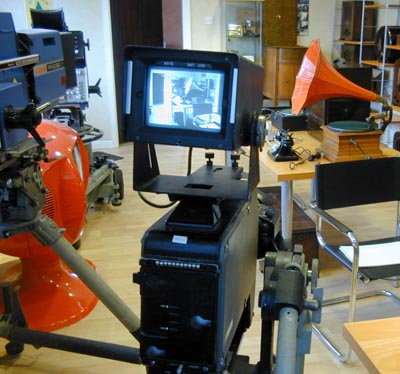
Ikegami HL79 from the collection on test. An ideal camera for use today to give 'tube camera' pictures. |
Ikegami HK-322
Introduced in the early 1980s, the 322 was claimed to be the first 'Automatic set-up' studio camera- (it depends what you call 'Automatic'- arguably Marconi had already done that, ten years before.) These are a superbly made camera that was reliable, rugged and gave very good pictures. 3 x 1" Plumbicon tubes, automatic registration and white balance. TV36 cable.
I was especially pleased to get hold of this example as it is originally from HTV's Culverhouse Cross studios, and might have been one of the cameras used on the first live broadcast programme that I lit (I think it was an item for 'Wales this Week', hardly a BAFTA winner, but it was exciting for me at the time.) These cameras would have been not far off new then. Culverhouse Cross was then a brand new purpose built studio which at the time was one of the largest in the UK.
I have the CCU but it is not working and I don't have any manuals so not a priority to work on it but it is in good clean condition. I actually got the CCU and OCP off eBay (for about a fiver), they had come from someone who had bought them at an auction with a load of other HTV bits from somewhere in South Wales. About a year later I got the head from another collector, with another CCU. HTV had at least 12 channels, mine is definitely from the studios as the OB ones were a lot more knocked about, and it has the logo of 'Studio 1' on one side, who were a facilities company composed of ex-HTV staff which took over the studio from HTV.
|
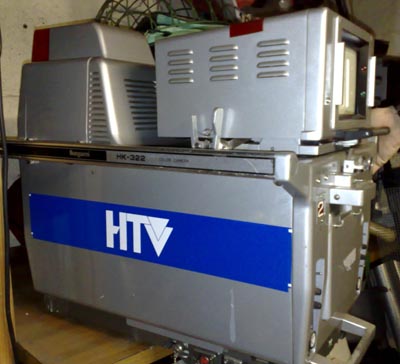 |
Ikegami HK-323 and 323P
A later 1980s development of the 322, slightly smaller and lighter. The studio version uses 1" tubes, while the very similar portable version uses 3/4" in the same 'Arrowhead' configuration. The Canon or Angeneiux lenses have a built in diascope which is used for the automatic functions, or a test chart can be used. (I would like one of these.) The head of the studio version has a built in Triax unit, or the head can be locally powered and set up, without the CCU, mainly for test purposes. A microprocessor is used to provide correction signals to the registration and colour balance circuits, the parameters being stored in EPROM on board the head. The parameters can be adjusted by the OCP or using a special master control unit which can align a number of cameras at once.
I have 2 ex -Granada 323 channels, and one which is ex BBC (Glasgow originally, then Leeds.) This has an Angeneiux lens which has a servo fault which I have been unable to sort out. There is a spare BBC head which is full of faulty boards. The Granada ones work- and I now have a third Granada head but am looking for a lens.
There are also 323-P (portable) versions, which contain very similar electronics in a smaller head, which was available with optional backs for studio multicore, ENG or Triax. I have 3 units with Triax backs, fitted with Canon lenses, one having the studio option viewfinder and lens remotes. The lenses have 2x extenders (local or OCP controlled) and built-in diascopes for auto line-up. Two are ex-Granada, one is a hybrid BBC Leeds/Granada, the Triax back having been salvaged from the BBC one which had been dropped from a great height. The Granada ones were originally from the 'This Morning' studio at the Albert Dock, Liverpool, and have survived hundreds of hours of looking at Richard and Judy.
They are typically well made and although they have had a hard life they still work OK, although some of the parameters are outside the auto adjustment range. A rather annoying feature of the automatic system is that if it cannot complete the line-up it aborts the proceedings, leaving all the adjustments out, even the ones it can correct. The OCPs are connected via a multi-core cable to the CCU, or can be connected directly to the head allowing remote control of automatic and manual functions as well as the usual iris and black level, ideal for single camera EFP.
I have another one with a non-Triax back which will connect to a portable recorder. That is a good unit and gives good pictures, we often use it with N3. They are a very nice camera in both portable and studio versions, very rugged and versatile. I have just acquired the Master Set-Up Unit which should prove useful in performing proper line-ups.
|
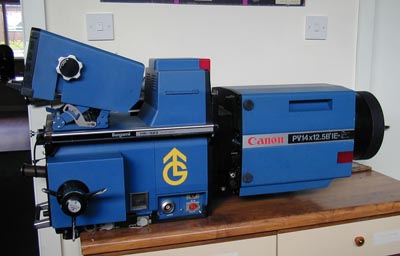
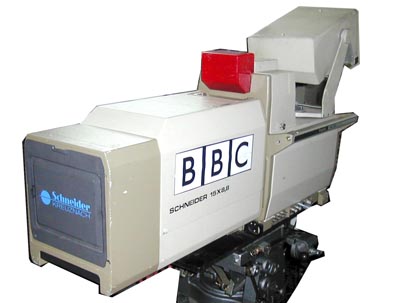
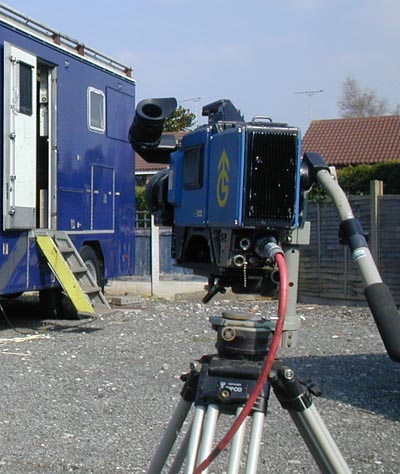
|
|
|
Link 110
Not really part of the collection as I don't have a camera head, although I did have several at one time when I had the museum. These came from the studio where I mainly worked, and were replaced with Sony 360s. They were made in the mid-1970s by a small company which I believe was started by ex BBC engineers. They copied the mechanical design of the popular EMI 2001, but made it a little smaller and lighter. They were however 3 tube (Plumbicons), and their main advantage was the use of lighter TV36 cable, with control signals, talkback etc. multiplexed to enable operation with fewer cores.
The main customer for Link was the BBC, and the 110 was designed to meet their rather eccentric requirements, reducing the saleability of the camera to other markets. Choice of lenses was quite good, but unfortunately neither the picture quality nor the standard of construction was as good as the 2001. They were not very successful on OBs, although they were used on the Open University scanner which was later used by BBC Wales. (I remember working on a joint BBC/HTV OB where they were in use.) For the collector today they are a bit of a disaster, as they are full of blue tantalums which are prone to going short, and early chips which are no doubt hard to find.
The BBC used 110s to some extent in studios (including Television Centre) but they never really ousted the 2001 and did not stand up well against the Philips LDK5 for OB use. Link also made a disasterous 'portable', the 120, which was similar in concept to the Marconi Mk.lXP in that it has a 'lump in the cable', a box containing all the stuff that won't fit in the head but is too far away in the CCU. The 120 was used to some extent in the early days of EFP but it was notoriously unreliable. We did have one on the camera complement at HTV but I never saw it used, it was left in storage, considered too risky to use and I got it for the museum when the studio shut down. Presumably it is now at Bradford. I think I still have the CCU and possibly the interconnecting cable.
I remember lighting for Link 110s, they were fairly soft and noisy. They didn't like loud music as I recall, the tubes used to rattle and give striations on the picture, and the board connections were a source of trouble.
I would like to get a 110 back. The ones I had were fitted with fixed manually controlled Varotal lenses, a cheap option. They didn't like wide apertures, flared and ramped badly.
|

I don't actually have this camera any more- it was one of the ones in the Broadcasting Museum collection. It was actually only a shell, with an EMI security camerea inside, but the lens (adapted using a piece of PVC drainpipe) was operational, as was the viewfinder, so visitors could operate the camera on the 1950s room set. The output appeared on the monitors in the recreated production gallery. The pedestal was bought from Harefield Hospital TV, it had been previously donated by LWT but was too large for their later cameras.
The Link cameras had been retired around 1988, and I lit the last programme to go on air using them. They were replaced with Sony 360s.
Behind the Link is a Marconi Mk.V11, ex- Southern Television. I regret this having gone as well, they are quite rare now. |
Link 125
The successor to the moderately successful 110, it is a sleeker styled camera but little different in concept. It uses what is basically the same CCU, multiplexing signals down the TV36 cable. I have 2 channels, both obtained from widely different locations but believed to have come originally from the same source, possibly originally BBC Northern Ireland? They were quite popular in the BBC so they were used in a number of studios.
The 125 was thought to be a lot better than the 110 and it looks better made, i.e. less like a biscuit tin. I can't imagine getting round to doing any work on them as you can bet they will be full of dud caps - still, one of the heads is very clean and there are at least 2 CCUs.
|
No pic yet |
Marconi Mk. VIII
This was quite a revolutionary camera in several ways, the most important being that it was the first camera to use an automatic registration system. This is a very clever idea, which used manual registration controls but applied error signals to little servo motors that turn the pots! Rather a bizarre idea, but it is quite impressive. You can scramble the settings in a terrifying way and watch as it restores them to their rightful places. Like all automatic things, good when working properly.
Line-up was a time consuming job on older cameras (such as the Mk.Vll) and ITV companies in particular liked the idea of anything that saved time and therefore money, not to mention reducing the power held by the engineers who operated the mysterious workings. The ITV companies were probably the target market, as the BBC who had been loyal customers of Marconi in the past seemed to turn their backs on them after the Mk. Vll, which they tried but didn't like.
The Mk. Vlll uses a diascope slide with a test pattern which is used for auto line-up, and the 3 Plumbicon tubes are arranged in a 'Cobbler's Last' sort of arrangement which accounts for the odd shape of the camera. The lens is on the right hand side, all the head boards being on the left, and the viewfinder is also towards the left. Many operators disliked it for this reason. I rather like the strange shape, which was continued in the Mk. lX which is very similar.They were quite a successful design, being relatively compact and using a lightweight version of the Mk.lV cable which was easier to handle than G101.
I have 2 channels, one of which was one of the original cameras from the Cardiff TWW (Television Wales and West) studios at Pontcanna. This studio was inherited by HTV when they got the franchise, and I did work there once or twice just before it was closed down and subsequently demolished. I remember seeing the MK.Vllls in the news studio, the side panels were open, the engineers said it was not worth closing them as they went wrong so often! To be fair, they were getting on a bit by then. When they were finally disposed of (replaced by Sony 360s) I rang the engineering manager and asked what had happened to the Marconis- (I was starting to plan the Museum at this time) and was told they had already all gone in a skip!
Fortunately, skips are often not the final resting place of equipment, and nearly 10 years later I had a phone call from an ex-HTV colleague who asked if I wanted one of the old Marconi cameras! A cameraman had rescued one of the heads from the skip and had kept it as a feature in his living room until his wife got fed up with it. There was no CCU of course, but the head was in good shape. I subsequently managed to get a CCU and then another complete channel. I have never tried to get either of them going, but it would be interesting to try and do so. I don't know where the other one came from originally- it is quite possible that it too could have been rescued from the skip or later sold by the skip contractor, you never know. Skip diving has saved a lot of wonderful things from oblivion over the years!
|
Awaiting pic of head.
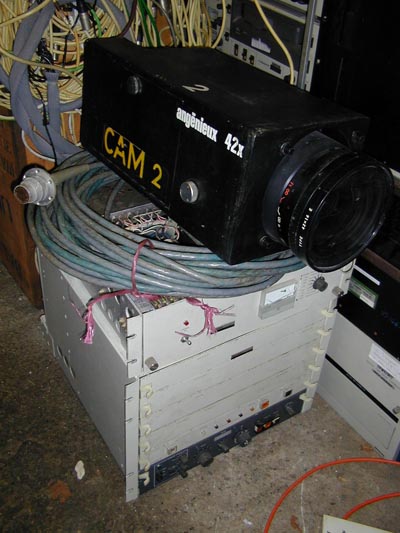
Mk.Vlll CCU and PSU. The lens above is from a MK.lX. |
Marconi Mk. IX
A later development of the Mk. Vlll, very similar in appearance. These were quite popular with ITV companies. The BBC did not use them. Granada TV replaced EMI 2001s with them, and many people considered it was a mistake. The pictures they produced did get a lot of adverse criticism.
I had one in the Museum which I got from someone who had bought an ex- Granada Range Rover and found it in the back! I now have one complete channel (ex LWT) and at least one semi-complete head. Like all Marconi stuff it is superbly made, their production standards were very high, presumably due to their experience with military electronics. LWT had a lot of Mk.lXs
The head power supplies were notorious, but another problem they have now is that the viewfinder tubes have some kind of glue behind the safety glass which tends to go crazed and opaque. We can't blame Marconis for that, it is a fault with the type of tube, and I don't suppose the manufacturer thought anyone would care in 30 years time.
|
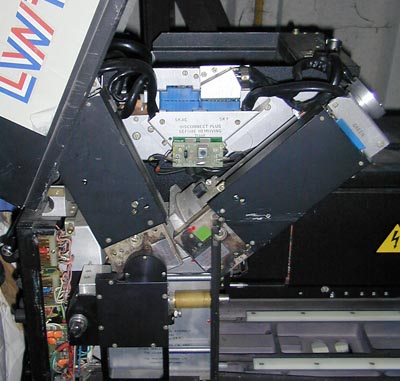
Tube arrangement in the Marconi MK.lX. The third tube is at right angles, projecting away from the block into the body of the camera. The lens has been removed- the slides on which it rests are visible. |
Philips LDK44
As mentioned above, these were an industrial/ educational camera, although they could be fitted with broadcast grade tubes at extra cost and would then have met standards at the time. As I recall, they cost about £10,000 per channel, which was less than half the price of a broadcast camera, but was top end for non-broadcast. They were supplied by Pye TVT, which would have been near the end of the road for that company.
They were designed to be used in either a studio or self-contained mode, for studio use the top half of the arrow-shaped camera was the viewfinder, but this could be removed and replaced by the CCU pack to make a stand-alone unit. As I remember we never did this, they were always used with the CCUs in a frame in the racks. They did give quite good pictures, even under low light conditions. It was about this time that the picture quality from sub-broadcast cameras began to rival the quality obtainable from broadcast units, although they would probably not have stood up to the rigours of broadcast use.
I have only got one of the heads, I think the CCUs got scrapped, so it will never work, it is just a bit of nostalgia as I remember helping to install them new, and learned a lot about lighting with them.
|
|
Pye Mk8
Pye made some serious contenders in the monochrome days, the Mk3 being quite a popular I.O. camera. They never truly entered the colour market, as the PC60/PC80 was really a Philips LDK3. This vidicon or Plumbicon tubed monochrome camera was probably designed for non-broadcast use, and as a telecine camera, but was adapted for a caption camera for the BBC Type 2 scanners. They were housed in a bulky unit containing a caption card holder and striplights, with provision for a slide projector to be fitted on top, and communications facilities. The camera was connected to the scanner by Mk.lV cable, and could be housed in the camera van or a convenient location. (The manuals suggest the CMCR cab, and there is a cable provided inside, but getting this huge lump into the cab looks impossible to me.)
The unit even without the projector is very heavy and awkward to move, and for some reason the camera is mounted vertically, a mirror being used to reflect the caption which is at 90 degrees to the camera. I presume the line scan can be reversed or the captions would read backwards!
Latert the BBC replaced them with a very home-made looking thing like a small sledge or stretcher, using a Link security type Vidicon camera, which is in line with the caption card holder. It is half the size and weight of the Pye unit.
I have both types, which are part of North 3s equipment. The Pye unit, which is minus the mirror (and projector if they ever had it) came with a pile of spare bits with N3. The CCU is in the CMCR racks. I also have the Link 'sledge' and the CCU from CMCR7, which is currently being restored.
|
|
Sony BVP1
The first Betacam camera, quite interesting as it uses a single Trinicon tube, developed from Sony's range of semi-pro cameras. It has a lens which won't fit anything else, and it was believed by the last owner to have never been used. I bought it on eBay from Edinburgh. It does work, and produces quite reasonable pictures considering what it is. It docks with the BVV-1 Beta recorder, of which I have several.
This recorder does what it says on the tin, it records. That's it- no transport controls, no playback. It takes only oxide Beta tapes, which are not easy to find, (unless you want to risk using domestic Betamax tapes, which will work but are of inferior construction) and if you look at the official specs it is not much better in performance than BVU, (in fact slightly worse resolution than BVU SP) which was the main competitor for ENG. Both systems were fine as long as you didn't need to do much editing, because the picture and sound go down the drain if you try taking either format to multiple generations.
The camera does look in as-new condition, unfortunately this cannot be said of the BVV-1s which look as if they have had a very hard life but seem to work OK.
|
|
Sony BVP3
The BVP3 was designed to form part of an integrated system which could be used as a lightweight studio camera for tripod or hand held use, a portable which could connect to a portable recorder or be docked with the BVV-5 Betacam SP recorder back. It was an advanced and well made unit with 3 Saticon tubes and a number of automatic features. It could be remotely controlled if connected by a lightweight multicore cable to the matching CCU and OCP. If used in this form the camera body is fitted with a studio back adaptor.
I have one very good example of this camera, and a couple of non-working bodies for spares. It has both monocular and studio type viewfinders, and a set of remote pan-bar lens controls, but it is missing the lens focus servo unit.
|
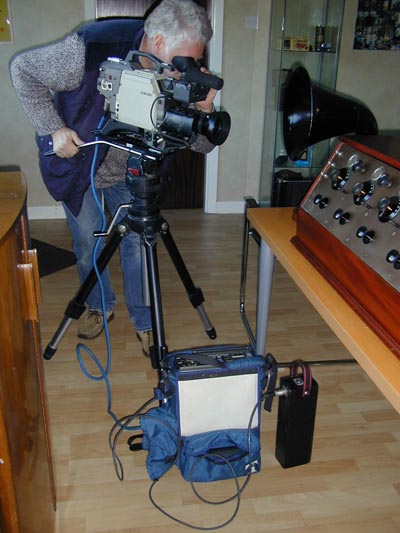
Sony BVP3 with BVU150 portable recorder |
Sony BVP300
text
|
|
| Pye Mk iii |
|
| EMI 203 |
|
| Marconi Mkiii |
|
| Marconi Mkiv |
|
| Ikegami 388W & PW |
|
| Sony BVP7 |
|
| |
|
| |
|
|

